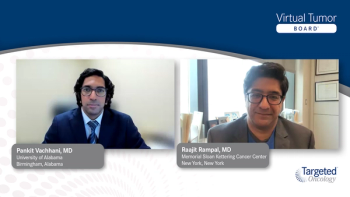
Treatment Options for pMMR Recurrent EC: KEYNOTE 775
Moderator Robert L. Coleman, MD, spearheads a review of clinical data from KEYNOTE 775, which combined lenvatinib with pembrolizumab in patients with endometrial carcinoma.
Episodes in this series

Transcript:
Robert L. Coleman, MD, FACOG, FACS: We’re becoming more comfortable with this lenvatinib [Lenvima]–pembrolizumab [Keytruda] regimen, which was brought to us through a series of trials. Before KEYNOTE-775, we had KEYNOTE-146. This was an eye-opener because it was a single-arm study. We saw remarkable responses to this unique regimen of an antiangiogenesis agent with an immune checkpoint inhibitor in a patient population that we didn’t expect to see a lot of responses. These patients had a proficient MMR [mismatch repair] status. It was strong enough that it was granted an accelerated approval. In the United States, to get a regular approval, you have to do a confirmatory trial. So KEYNOTE-775 was important. Those of you following the story should know that the updated data on KEYNOTE-146 were just published in JCL [Journal of Clinical Oncology]. It’s important because, in that update, they also have longer follow-up for the duration of response, and there are a lot of similarities with KEYNOTE-775, which is reassuring. There’s a unique tail to the curve that was well described by Vicky Makker in that paper.
The study took patients with advanced metastatic and recurrent endometrial cancer who had measurable disease by BICR [blinded independent central review], and they had to have had at least 1 platinum-based chemotherapy regimen with good performance status and have MMR testing available. The stratification factors are important. We were looking at the pMMR [proficient MMR] population primarily from the statistical analytical point, but we also knew there were going to be deficient MMR [dMMR] patients enrolled in this trial. They looked at those patients separately in the stratification side: dMMR patients were enrolled, and pMMR were further classified by stratification variables of region of the world, performance test, and the presence or absence of public radiation.
As for the regimen itself, lenvatinib was given 20 mg daily, and pembrolizumab was given at the standard dosage of 200 mg IV [intravenous] every 3 weeks. We were given choice of chemotherapy for comparator. Doxorubicin was given at what a lot of people will consider a decent dose, 60 mg/m2, or weekly paclitaxel. These 2 single agents in the recurrent space have been studied extensively, around the world and by the Gynecologic Oncology Group, as the 2 most active agents. In fact, they were so active that both drugs were moved into the frontline setting—initially doxorubicin and then paclitaxel. These are our most active of those left over. The primary end points of this trial was PFS [progression-free survival] and overall survival. Analytically, objective response rate was also looked at.
The patient population was over 820 patients, which is well balanced. The pMMR-dMMR ratio was about 85:15. Krish, were you surprised that the dMMR proportion was around 16%?
Krishnansu S. Tewari, MD:I was a little surprised, but because we had the accelerated approval from phase 2, it’s possible that people were enrolling their MMR-proficient patients preferentially on this trial.
Robert L. Coleman, MD, FACOG, FACS:At the time we also had the tumor-agnostic indication for pembrolizumab in patients who were dMMR. This is what you see when you do a trial like this, when you have availability of therapy that aligns with a biomarker. That was pretty good. About 40% of these patients have had prior pelvic radiation, and you can also see the breakdown by histology. In this study, although carcinosarcomas weren’t allowed, their serous carcinoma population was one-quarter. This was an important component. We’re going to come back to that characteristic when we look at outcomes.
The statistical analytical plan was set up in 1 of these graphical, hierarchical methodologies that were popular 5 years ago, looking at a cohort of patients who were defined by a biomarker. In this case, they focused on pMMR populations. We wouldn’t expect a single agent of either of these drugs to be all that active, particularly with respect to the immune checkpoint inhibitor. If this was positive, then they’d pass that alpha onto the ITT [intent-to-treat] population, the all-comers population. If that was positive, they’d pass the same alpha onto the overall survival in the same 2 subgroups. And if that was positive, to objective response in the same 2 subgroups.
We’ll just work through this quickly because it’s a very consistent story. You can see that the hazard ratio for this initial assessment was at 0.60, which was highly significant. At the median, it was basically a doubling of the expectation for progression-free survival. Because that was positive, it was passed on to the all-comers population. What’s missing in this patient population, between the pMMR and the all-comers population, is the dMMR population. In that patient population, we’d expect pembrolizumab by itself to provide some benefit. When you think about this from a strategic standpoint, testing the pMMR cohort first was going to automatically apply to the all-comers population because it could only get better. That’s exactly what happened. The hazard ratio dropped. It went down from 0.60 to 0.56. Because that was positive, the analysis was passed on to overall survival.
In the pMMR population there was an improvement of hazard ratio to 0.68, about a 32% reduction in the probability for death. That translated into the median overall survival of 17.4 vs 12 months. Because that was positive, the alpha was passed to the all-comers population. As we expect, it got better; the hazard ratio dropped from 0.68 to 0.62. Because that was positive, the alpha was then passed on to the objective response. Looking at the pMMR population, followed by the all-patient population, the objective response rate was doubled from 15% to 30.3%. In the all-comers population, it was a little better: from 14.7 to 31.9 months. The proportion of complete responses, which are rare, went up by that same amount. What was impressive in this population was the duration of that response, which was 9.2 months in the pMMR population, 14.4 months in all comers, and not able to be calculated because of the flatness of the curve beyond 14 months.
This was confirmatory. But to have this expectation for chemotherapy and to see how well it was done, for many of us, was exciting. If you look at subsequent therapy, lenvatinib and pembrolizumab as a combination was used in over one-quarter of the patients who were initially evaluated in the ITT populational overall. Most of those were patients who got chemotherapy and then switched on a next line or subsequent line of therapy.
There were more adverse events [AEs] in the lenvatinib-pembrolizumab arm, particularly high-grade toxicities. If you look under grade 3 and plus, you can see that the expected adverse events, such as hypertension, and some of the immune-related adverse events were seen in that combination. We’ll talk a little about these adverse events, but the hypertension was not insignificant. It led to a fair number of patients coming off or requiring a dose reduction, and you can see that the dose reductions due to AEs were in two-thirds of the patients. This has caused quite a bit of discussion about how we approach patients with this regimen, knowing that it’s going to be the expectation. I’m curious to hear about how our experts handle that issue.
Transcript edited for clarity.











































